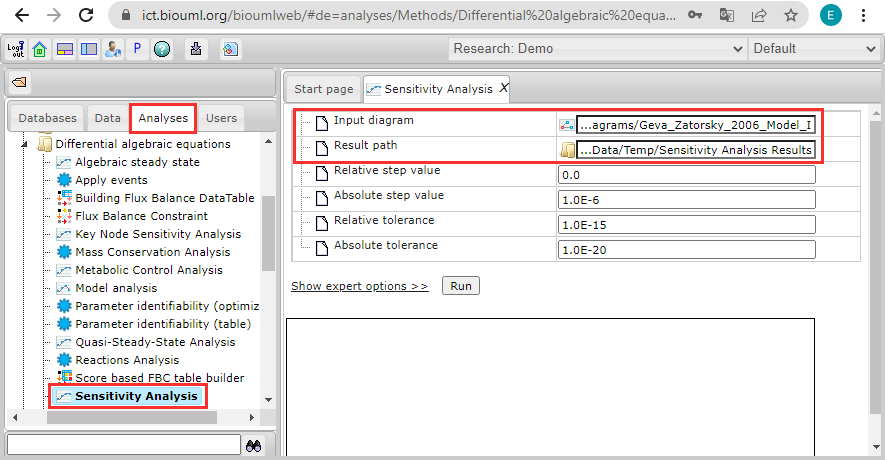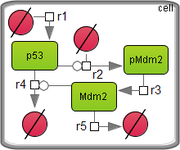Difference between revisions of "Sensitivity analysis example"
(→Reproducing the method in BioUML) |
|||
| (23 intermediate revisions by one user not shown) | |||
| Line 1: | Line 1: | ||
| + | <font size=3> | ||
| + | |||
The method description could be found in the section [[Sensitivity Analysis]]. Here we give an example of the method application and using in BioUML. | The method description could be found in the section [[Sensitivity Analysis]]. Here we give an example of the method application and using in BioUML. | ||
| + | |||
| + | ==Reproducing a test case in BioUML== | ||
| + | |||
| + | To reproduce a test case below in the [[BioUML]] workbench, go to the <b>Analyses</b> tab in the navigation pane and follow to ''analyses'' > ''Methods'' > ''Differential algebraic equations''. | ||
| + | |||
| + | After double click on ''Sensitivity Analysis'', a new tab with analysis settings opens. | ||
| + | |||
| + | Select a path to the example diagram: | ||
| + | |||
| + | ''data/Examples/DAE models/Data/Diagrams/Geva_Zatorsky_2006_Model_I'' | ||
| + | |||
| + | and a path to save results of analysis, for example: | ||
| + | |||
| + | ''data/Collaboration/Demo/Data/Temp/Sensitivity Analysis Results'' | ||
| + | |||
| + | <br>[[File:sa_figure_1.png]]<br><br> | ||
| + | |||
| + | After you click the <b>Run</b> button and the calculations are finished, you can see the results presented in two tables, including scaled and unscaled sensitivities. | ||
| + | |||
| + | Ready analysis results can be found here: | ||
| + | |||
| + | ''data/Examples/DAE models/Data/Sensitivity Analysis Results'' | ||
| + | |||
| + | ==Description of the test case== | ||
Consider the model of p53 and Mdm2 proteins regulation described by Geva-Zatorsky ''et al.'' [1]. The model includes the negative feedback loop in which p53 transcriptionally activates an Mdm2 precursor (pMdm2) representing, for example Mdm2 mRNA, and produces subsequent synthesis of Mdm2. Active Mdm2 increases the degradation rate of p53. The list of the model reactions is done in the table below, where ''x'', ''y'' and ''y''<sub>0</sub> denote concentrations of p53, Mdm2 and pMdm2 respectively. | Consider the model of p53 and Mdm2 proteins regulation described by Geva-Zatorsky ''et al.'' [1]. The model includes the negative feedback loop in which p53 transcriptionally activates an Mdm2 precursor (pMdm2) representing, for example Mdm2 mRNA, and produces subsequent synthesis of Mdm2. Active Mdm2 increases the degradation rate of p53. The list of the model reactions is done in the table below, where ''x'', ''y'' and ''y''<sub>0</sub> denote concentrations of p53, Mdm2 and pMdm2 respectively. | ||
| Line 22: | Line 48: | ||
<td>r2</td> | <td>r2</td> | ||
<td>-p53 → pMdm2</td> | <td>-p53 → pMdm2</td> | ||
| − | <td>''x''</td> | + | <td>''β<sub>y</sub>'' · ''x''</td> |
</tr> | </tr> | ||
<tr> | <tr> | ||
| Line 63: | Line 89: | ||
[[File:sa_formula_5.png]] | [[File:sa_formula_5.png]] | ||
| − | |||
| − | |||
| − | |||
| − | |||
| − | |||
| − | |||
| − | |||
| − | |||
| − | |||
| − | |||
| − | |||
| − | |||
| − | |||
| − | |||
| − | |||
| − | |||
==References== | ==References== | ||
# Geva-Zatorsky N., Rosenfeld N., Itzkovitz S., Milo R., Sigal A., Dekel E., Yarnitzky T., Liron Y., Polak P., Lahav G., Alon U. Oscillations and variability in the p53 system. ''Molecular Systems Biology''. 2006. V. 2, № 2006.0033. | # Geva-Zatorsky N., Rosenfeld N., Itzkovitz S., Milo R., Sigal A., Dekel E., Yarnitzky T., Liron Y., Polak P., Lahav G., Alon U. Oscillations and variability in the p53 system. ''Molecular Systems Biology''. 2006. V. 2, № 2006.0033. | ||
| + | |||
| + | </font> | ||
Latest revision as of 10:48, 16 March 2022
The method description could be found in the section Sensitivity Analysis. Here we give an example of the method application and using in BioUML.
[edit] Reproducing a test case in BioUML
To reproduce a test case below in the BioUML workbench, go to the Analyses tab in the navigation pane and follow to analyses > Methods > Differential algebraic equations.
After double click on Sensitivity Analysis, a new tab with analysis settings opens.
Select a path to the example diagram:
data/Examples/DAE models/Data/Diagrams/Geva_Zatorsky_2006_Model_I
and a path to save results of analysis, for example:
data/Collaboration/Demo/Data/Temp/Sensitivity Analysis Results
After you click the Run button and the calculations are finished, you can see the results presented in two tables, including scaled and unscaled sensitivities.
Ready analysis results can be found here:
data/Examples/DAE models/Data/Sensitivity Analysis Results
[edit] Description of the test case
Consider the model of p53 and Mdm2 proteins regulation described by Geva-Zatorsky et al. [1]. The model includes the negative feedback loop in which p53 transcriptionally activates an Mdm2 precursor (pMdm2) representing, for example Mdm2 mRNA, and produces subsequent synthesis of Mdm2. Active Mdm2 increases the degradation rate of p53. The list of the model reactions is done in the table below, where x, y and y0 denote concentrations of p53, Mdm2 and pMdm2 respectively.
|
Assume βx = 0.3, βy = 0.4, α0 = αy = 0.1 and αxy = 3.2, and solve the algebraic system:
As a result we obtain the following steady state of the model:
Exploring the unscaled sensitivity of this state to perturbations of parameters βx, βy, α0, αxy and αy, we can find the matrix of partial derivatives:
Substituting the values of the investigated parameters, we get:
Scaled sensitivities could be found by the following way:
[edit] References
- Geva-Zatorsky N., Rosenfeld N., Itzkovitz S., Milo R., Sigal A., Dekel E., Yarnitzky T., Liron Y., Polak P., Lahav G., Alon U. Oscillations and variability in the p53 system. Molecular Systems Biology. 2006. V. 2, № 2006.0033.






